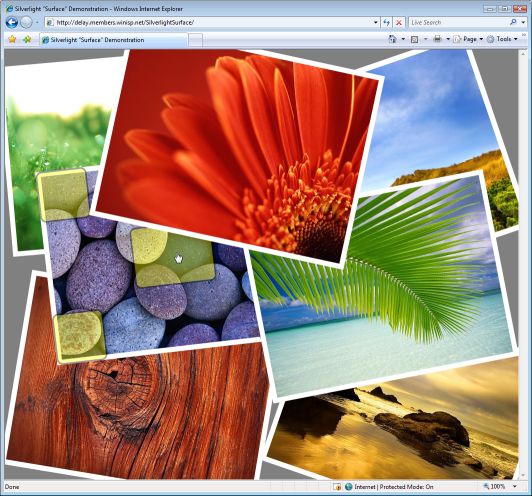Silverlight "Surface" Demonstration [Silverlight implementation of Surface's "photo table" UI]
Yesterday, Microsoft announced its Surface product to much buzz and excitement. The demo videos I saw featured a "photos on a table" user interface that displayed a handful of photos sitting on the Surface. The interface allowed people to easily move the virtual photos around by touching them in the center and sliding them to a different location on the screen. By touching the corners instead, photos could be sized and rotated with ease.
It struck me that this interface would be pretty easy to replicate with Silverlight and I decided to do so as a learning exercise. I spent some time on this last night and tonight and came up with an application that looks like this:

You can click here (or on the image above) to play with the application in your browser. The code's quite simple; click here to download the source code and play around with it yourself! (To build the project, you'll want to use Visual Studio Orcas Beta 1 and the Silverlight Tools.)
Notes:
- When the application loads, it randomly lays out the sample photos. To interact with a photo, simply move the mouse pointer over the photo and click+drag on one of the yellow control elements that appears. The center element moves the photo around and the corner elements all rotate/resize it. Click on any part of a photo to bring it to the top of the pile.
- Without the snazzy Surface hardware support, this application doesn't support the Human Finger 1.0 input device. :) However, if you run it on a Tablet PC or hooked up to something like the Wacom Cintiq, you can get pretty close.
- As expected, Silverlight's XAML support makes this kind of interface pretty easy to build. I understand the Surface UI was written using WPF (Silverlight's big brother), so I suspect some of the techniques they used are fairly similar to what's being done here.
- The sample images are a few of my favorite wallpapers that come with Windows Vista. I have not included them with the code download because they're large and it's easy enough to copy them from your own
%windir%\Web\Wallpaperdirectory. Or just use your own favorite images! - I don't demonstrate it here (partly because I don't have a good nature video), but it would be easy to add video support so that each of the photos was a streaming video instead. Hum, maybe I'll do a follow-up post... :)
It's pretty obvious that XAML lets you do some pretty neat things with ease - I look forward to even more compelling new interfaces based on Silverlight and WPF!